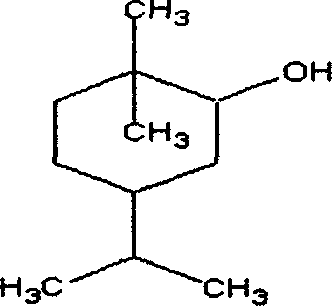Ophthalmic solution containing borneol and usage thereof
A solution and ophthalmology technology, applied in glasses/protective glasses, glasses/goggles, optics, etc., can solve the problems of increasing inconvenience and achieve the effect of relieving heat and moisturizing sensation
- Summary
- Abstract
- Description
- Claims
- Application Information
AI Technical Summary
Problems solved by technology
Method used
Image
Examples
Embodiment 1
[0082] Prepare various reagents according to the recipes in Table 1.
[0083] Component
Recipe 1
Recipe 2
Recipe 3
Recipe 4
Recipe 5
ice flakes
0.0001
0.001
3
50
80
50
20
13
5
0.001
sodium borate
---
0.5
1.0
0.7
---
80
40
9
3
0.05
0.001
50
18
3
0.03
0.02
1
1.8
4.5
7.5
(BASF Corporation)
0.01
2
16
70
100
0.1
0.1
0.1
0.1
0.1
TRIS-HCl
1
1
1
1
1
Potassium sorbate
---
---
1
3
7.98
sodium hydroxide or hydrochloric acid
(concentration is 1N)
Regulate acid-base
...
Embodiment 2~5
[0088] Examples 2-5 illustrate the effect of solutions of the present invention on cleaning protein deposits accumulated on the surface of hydrophilic contact lenses (FDA Class IV, for example, J&J Survue® hydrogel lenses with a water content of 58%).
[0089] The cleaning ability of lens deposits can be compared by the following method: use the solution to be tested to treat soft lenses that have been pre-deposited with lysozyme and calf tear protein solution (called artificial tears) (here the water content 58% of the FDA Type IV soft lens), respectively measure the UV absorbance value of the artificial tear before and after treating the lens, and the UV absorbance value of the solution after treating the lens. The difference in the UV absorbance value of the artificial tear before and after treating the lens is The amount of protein deposited on the lens, and the UV absorbance value of the solution to be tested is the amount of protein eluted, and the ratio of the two is the...
Embodiment 6~13
[0095] Examples 6-13 illustrate the effect of the solution of the present invention on the bactericidal effect.
[0096] Test challenge The experimental strains used were Staphylococcus aureus (ATCC6538), Pseudomonas aeruginosa (ie, Pseudomonas aeruginosa, ATCC9027), Escherichia coli (8099) and Candida albicans (ATCC10231). After each microorganism is cultured in a suitable medium to a suitable bacterial concentration (such as 107~108cfu / ml), each solution to be tested is inoculated with a certain amount of challenging microbial suspension, and the number of bacteria after inoculation is 105~106cfu / ml , The number of bacteria can be evaluated by turbidity method or culture method. The volume of the inoculum suspension should not exceed 1% of the total volume. Shake to make the bacteria liquid evenly distributed, place the test solution at a suitable temperature after inoculation to allow the inoculated bacteria to grow normally, and count the colonies of the test solution aft...
PUM
 Login to View More
Login to View More Abstract
Description
Claims
Application Information
 Login to View More
Login to View More - R&D
- Intellectual Property
- Life Sciences
- Materials
- Tech Scout
- Unparalleled Data Quality
- Higher Quality Content
- 60% Fewer Hallucinations
Browse by: Latest US Patents, China's latest patents, Technical Efficacy Thesaurus, Application Domain, Technology Topic, Popular Technical Reports.
© 2025 PatSnap. All rights reserved.Legal|Privacy policy|Modern Slavery Act Transparency Statement|Sitemap|About US| Contact US: help@patsnap.com


